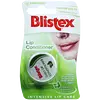What's inside
What's inside
 Key Ingredients
Key Ingredients

 Benefits
Benefits

 Concerns
Concerns

 Ingredients Side-by-side
Ingredients Side-by-side

Petrolatum
EmollientLanolin
EmollientCandelilla Cera
EmollientEthylhexyl Methoxycinnamate
UV AbsorberParfum
MaskingTocopheryl Acetate
AntioxidantOlea Europaea Fruit Oil
MaskingVitis Vinifera
MaskingTheobroma Cacao Husk
AbrasiveAloe Barbadensis Sprout
HumectantAroma
Benzyl Alcohol
PerfumingBenzyl Benzoate
AntimicrobialCamphor
MaskingCera Microcristallina
Emulsion StabilisingCetyl Alcohol
EmollientCocoyl Hydrolyzed Soy Protein
CleansingIsostearoyl Hydrolyzed Collagen
CleansingLimonene
PerfumingMenthol
MaskingSaccharin
MaskingThymol
AntimicrobialPetrolatum, Lanolin, Candelilla Cera, Ethylhexyl Methoxycinnamate, Parfum, Tocopheryl Acetate, Olea Europaea Fruit Oil, Vitis Vinifera, Theobroma Cacao Husk, Aloe Barbadensis Sprout, Aroma, Benzyl Alcohol, Benzyl Benzoate, Camphor, Cera Microcristallina, Cetyl Alcohol, Cocoyl Hydrolyzed Soy Protein, Isostearoyl Hydrolyzed Collagen, Limonene, Menthol, Saccharin, Thymol
Hydrogenated Polyisobutene
EmollientPhytosteryl/Isostearyl/Cetyl/Stearyl/Behenyl Dimer Dilinoleate
Skin ConditioningHydrogenated Poly(C6-14 Olefin)
EmollientDiisostearyl Malate
EmollientPolybutene
Phytosteryl Isostearyl Dimer Dilinoleate
EmollientMicrocrystalline Wax
Emulsion StabilisingButyrospermum Parkii Butter
Skin ConditioningSucrose Tetrastearate Triacetate
EmollientEthylene/Propylene/Styrene Copolymer
Synthetic Wax
AbrasiveMica
Cosmetic ColorantEuphorbia Cerifera Wax
Astrocaryum Murumuru Seed Butter
EmollientParfum
MaskingCandelilla Wax Esters
CI 77891
Cosmetic ColorantPolyglyceryl-2 Diisostearate
EmulsifyingDimethicone
EmollientDehydroacetic Acid
PreservativeButylene/Ethylene/Styrene Copolymer
Methicone
EmollientCopernicia Cerifera Wax
Polyglyceryl-2 Triisostearate
EmulsifyingCI 15850
Cosmetic ColorantPentaerythrityl Tetra-Di-T-Butyl Hydroxyhydrocinnamate
AntioxidantCI 42090
Cosmetic ColorantPolyhydroxystearic Acid
EmulsifyingBHT
AntioxidantHydrogenated Polyisobutene, Phytosteryl/Isostearyl/Cetyl/Stearyl/Behenyl Dimer Dilinoleate, Hydrogenated Poly(C6-14 Olefin), Diisostearyl Malate, Polybutene, Phytosteryl Isostearyl Dimer Dilinoleate, Microcrystalline Wax, Butyrospermum Parkii Butter, Sucrose Tetrastearate Triacetate, Ethylene/Propylene/Styrene Copolymer, Synthetic Wax, Mica, Euphorbia Cerifera Wax, Astrocaryum Murumuru Seed Butter, Parfum, Candelilla Wax Esters, CI 77891, Polyglyceryl-2 Diisostearate, Dimethicone, Dehydroacetic Acid, Butylene/Ethylene/Styrene Copolymer, Methicone, Copernicia Cerifera Wax, Polyglyceryl-2 Triisostearate, CI 15850, Pentaerythrityl Tetra-Di-T-Butyl Hydroxyhydrocinnamate, CI 42090, Polyhydroxystearic Acid, BHT
 Reviews
Reviews

Ingredients Explained
These ingredients are found in both products.
Ingredients higher up in an ingredient list are typically present in a larger amount.
Parfum is a catch-all term for an ingredient or more that is used to give a scent to products.
Also called "fragrance", this ingredient can be a blend of hundreds of chemicals or plant oils. This means every product with "fragrance" or "parfum" in the ingredients list is a different mixture.
For instance, Habanolide is a proprietary trade name for a specific aroma chemical. When used as a fragrance ingredient in cosmetics, most aroma chemicals fall under the broad labeling category of “FRAGRANCE” or “PARFUM” according to EU and US regulations.
The term 'parfum' or 'fragrance' is not regulated in many countries. In many cases, it is up to the brand to define this term.
For instance, many brands choose to label themselves as "fragrance-free" because they are not using synthetic fragrances. However, their products may still contain ingredients such as essential oils that are considered a fragrance by INCI standards.
One example is Calendula flower extract. Calendula is an essential oil that still imparts a scent or 'fragrance'.
Depending on the blend, the ingredients in the mixture can cause allergies and sensitivities on the skin. Some ingredients that are known EU allergens include linalool and citronellol.
Parfum can also be used to mask or cover an unpleasant scent.
The bottom line is: not all fragrances/parfum/ingredients are created equally. If you are worried about fragrances, we recommend taking a closer look at an ingredient. And of course, we always recommend speaking with a professional.
Learn more about Parfum